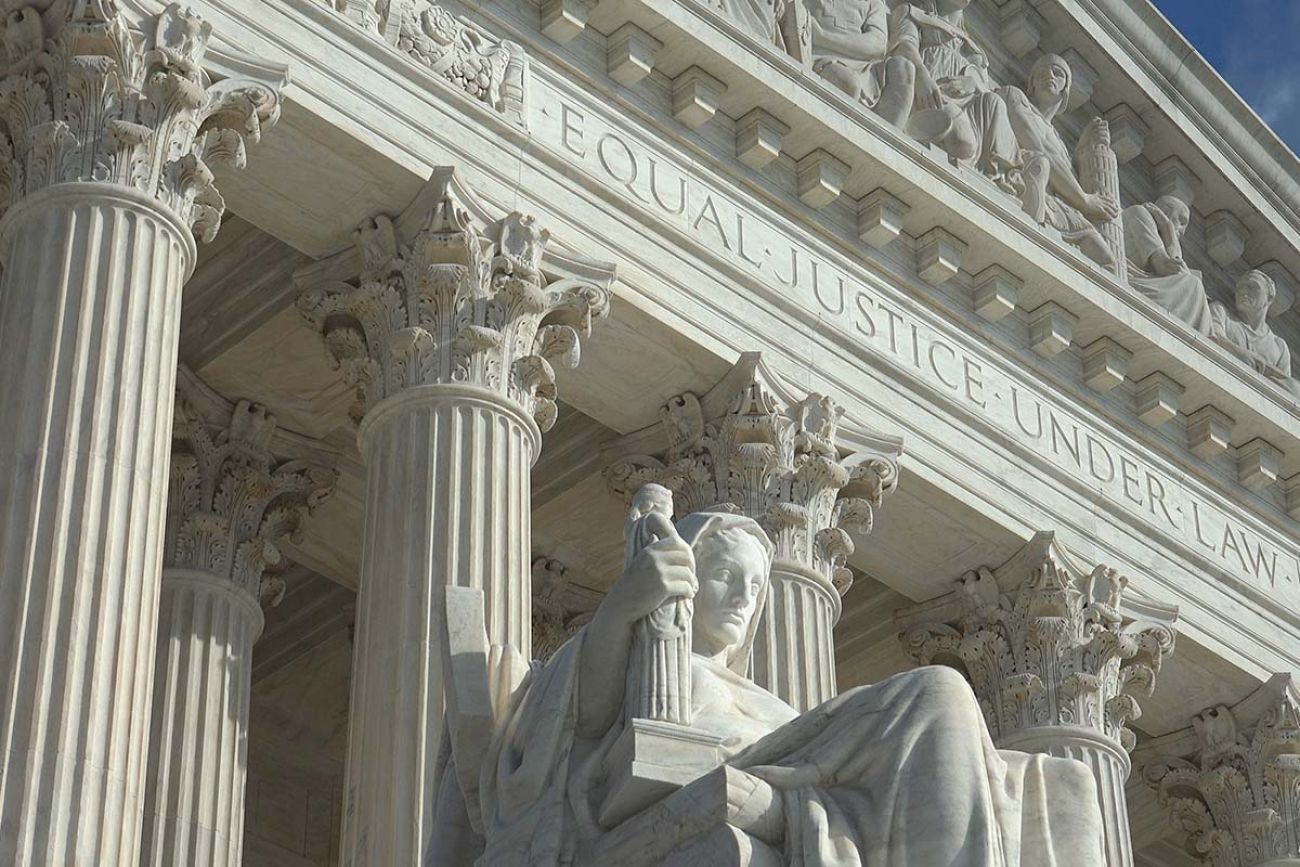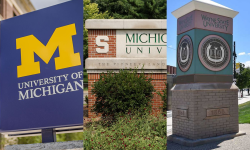Michigan student loan forgiveness: What to know as Supreme Court steps in

- The U.S. Supreme Court will hear arguments Tuesday on President Biden’s student loan forgiveness program
- Over 500,000 Michigan borrowers have already been approved for loan forgiveness but their relief is on hold
- Biden’s plan would forgive up to $20,000 for student loan borrowers
The U.S. Supreme Court will hear oral arguments Tuesday on the future of President Joe Biden’s student loan forgiveness program.
Student loan borrowers are waiting to see how justices on the conservative-tilting court will view Biden’s effort to clear college debt for millions of people, a plan halted by lower courts before it could be implemented.
The program, announced last August, fulfills a campaign pledge from Biden when he ran for president in 2020. It would provide individual borrowers who earn under $125,000 a year or are in households that make under $250,000 up to $10,000 in loan cancellation. Borrowers who qualified for Pell Grants, which are given to low-income students, would be eligible for loan cancellation up to $20,000. (Only government loans are included in the Biden program, not private loans.)
Related:
- Michigan student loan borrowers will have more time before payments resume
- See Biden’s student loan forgiveness application form
- Biden student loan forgiveness plan: What it means for Michigan
Here’s what to know about the upcoming arguments, and what’s at stake:
Why did the Biden administration create the program?
The White House has framed the program as a way to help both individual borrowers and the broader economy. Collection on student loans has been paused across the U.S. since March 2020, one of several emergency financial measures put in place early in the pandemic. Biden’s program is framed as an extension of that emergency help.
When it was announced last August, the Biden administration planned to have borrowers resume making loan payments at the start of 2023. And loan forgiveness was supposed to provide “breathing room” to borrowers as people prepared to resume payments.
In addition to the pandemic, the administration cited the rising cost of attending a four-year college, with declining government’s support for students.
“That has left many students from low- and middle-income families with no choice but to borrow if they want to get a degree,” the administration said in a White House fact sheet.
More broadly, the White House argued “high monthly payments and ballooning balances'' have stopped the middle class from building wealth. It cited studies that link the burden of student loans to negative effects related to home buying, saving for retirement and starting small businesses.
It’s a burden that falls more heavily on borrowers of color.
Black students are more likely to borrow money for school and more likely to take out larger loans, the administration said. Additionally, Black borrowers are more likely to receive Pell Grants compared to white peers.
How many Michigan borrowers are eligible for the program?
There were about 864,000 people in Michigan who applied or were automatically deemed eligible for relief before the administration was required to stop accepting applications, the White House said in January.
There were about 566,000 fully-approved applications in Michigan that had been sent to loan servicers for discharge at the time.
Nationally, there were over 26 million people who applied for the program and close to 16.5 million people with fully-approved applications.
The Education Data Initiative estimates there are a total of 1.4 million student loan borrowers in Michigan, with a collective debt of roughly $51 billion. State borrowers’ average debt is $36,116. Within this group, 16 percent owe less than $5,000 while 21.6 percent owe between $20,000 to $40,000. Two percent of borrowers owe more than $200,000.
Who’s challenging the Biden plan and what’s their argument?
The Court will hear arguments in two cases related to student loan relief: Biden V. Nebraska and Department of Education V. Brown.
The first case involves six conservative states — Nebraska, Missouri, Arkansas, Iowa, Kansas and South Carolina. The second case is brought by two individuals.
Of the two individuals, one is eligible for $10,000 in loan forgiveness while the other is not eligible at all. They are backed by the Job Creators Network Foundation, a nonprofit that focuses on free market policies. Bernie Marcus, the co-founder of Home Depot, founded the Job creators Network Foundation.
What legal questions are before the justices?
Jonathan Glater, a law professor at University of California, Berkeley, told Bridge Michigan there are two main questions at play: Do the people suing to challenge the debt relief plan have standing to proceed? And does Biden’s Secretary of Education have the authority to cancel student loan debt en masse?
Both plaintiff groups argue they have standing — that is, that they would be negatively impacted by Biden’s plan.
In the suit brought by the states, they argue the U.S. Department of Education exceeded any emergency authority it possessed due to the pandemic by canceling student loan debt.
The individuals argue the Department of Education violated the Administrative Procedure Act and that the individuals were unable to submit their input on loan forgiveness ahead of the program being announced.
Glater, who has signed onto an amicus brief in support of the Department of Education, said the justices are also dealing with a political question.
“This is a signature initiative of the Biden administration,” he said. “To the extent that the court undermines it with an adverse ruling, the court is intervening into a political decision: How much should we be subsidizing higher education?”
It’s unclear how the Court will rule but the Washington Post reports that the issue is coming before a mostly conservative court that has been “skeptical of the (Biden) administration’s authority to impose pandemic-related relief without express approval from Congress.”
Why did the lower courts halt the program?
In the case involving the six states, a U.S. District judge first said the parties did not have standing. But soon after, the states filed an appeal and a panel with the Eighth U.S. Circuit Court of Appeals issued a temporary stay, or delay in the program taking effect.
The administration asked the Supreme Court to weigh in.
In the case with the two student loan borrowers, Judge Mark Pittman, of U.S. District Court for the Northern District of Texas ruled that the HEROES Act — a law that grants the education secretary the power to change the terms of student loans during an emergency —“does not provide ‘clear congressional authorization’ for the Program proposed by the Secretary.”
Pittman was also skeptical that COVID is still considered a “national emergency” under the HEROES Act given that Biden has already claimed the pandemic was “over.”
At that point, the federal government then stopped accepting applications for loan forgiveness.
What’s the economic impact if loan forgiveness is allowed?
The Biden Administration estimates that among borrowers no longer in school, almost 90 percent of relief money will go toward those earning less than $75,000 a year, providing a needed economic boost.
But it won’t come cheap. The nonpartisan Congressional Budget Office estimates the loan forgiveness program would cost the federal government $400 billion.
Economists are split on how the program would affect inflation.
What happens if the Supreme Court rules against the plan?
Borrowers would eventually have to resume making payments on their remaining loans, regardless of whether Biden’s plan is struck down.
Last November, the U.S. Education Department announced student loan payments would resume 60 days after the department is able to implement the student loan forgiveness program or the litigation is resolved.
If neither of those results have happened by June 30, then payments would start 60 days after that, on Sept. 1.
It’s also possible the Biden administration could try other strategies to implement student loan forgiveness. But Forbes reports that officials have said there is not currently a back up plan for if the court blocks the program.
In the meantime, the Biden administration is working to lessen the burden on borrowers with lower incomes.
CNN reports the plan would reduce the amount of discretionary income borrowers would have to pay, make it so unpaid interest would not accrue and shorten the time it takes for loans to be forgiven. The administration is proposing changes through the administrative formal rulemaking process which includes a public comment period.
While the student loan forgiveness plan before the Supreme Court would give one-time relief to current borrowers, the changes to repayment plans would provide broader relief to borrowers moving forward.
Michael Brickman, an adjunct fellow at the American Enterprise Institute, told the Hechinger Report that if the Court strikes down the loan forgiveness plan, attention could turn toward other executive actions to help relieve student debt.
When will the case be decided?
The Court could make a decision anytime after it hears oral arguments. But the Court often releases major decisions at the end of its term in late June or early July. The Court streams audio of the oral arguments on its website.
Michigan Education Watch
Michigan Education Watch is made possible by generous financial support from:
Subscribe to Michigan Health Watch
See what new members are saying about why they donated to Bridge Michigan:
- “In order for this information to be accurate and unbiased it must be underwritten by its readers, not by special interests.” - Larry S.
- “Not many other media sources report on the topics Bridge does.” - Susan B.
- “Your journalism is outstanding and rare these days.” - Mark S.
If you want to ensure the future of nonpartisan, nonprofit Michigan journalism, please become a member today. You, too, will be asked why you donated and maybe we'll feature your quote next time!





